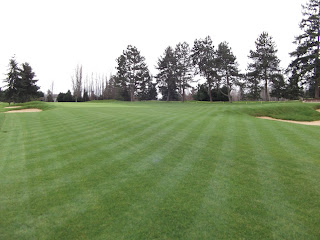 |
| An ultra-wide entrance to the green at Overlake's 12th hole, restored. |
There are several problems with narrow entrances. First, they aggravate weaker golfers who tend to play shots along the ground and, in turn, benefit from a legitimate chance to bounce the ball onto the greens. Low handicappers play golf more through the air than ever these days. They're unaffected by narrow entrances. This set-up contradicts the ideal in golf architecture, which is to present adequate challenge to better golfers while at the same time allowing less skilled players to enjoy the game.
Another issue with narrow entrances is purely aesthetic. Where there are no reasons for the fairway to become arbitrarily narrow leading into the greens (ie greenside bunkers), so many holes simply look chintzy because the scale of the fairway cut is wrong. (You don't see skinny necks of fairway leading into the greens at St. Andrews, Royal Melbourne, Cypress Point, Augusta National and all of those other great courses long recognized as the world's best.)
At Overlake Golf and Country Club's 12th hole, we quadrupled the width of the entrance to the green. Before we arrived in Seattle, this 200-yard + par-three featured a ridiculously skinny neck of fairway running into the putting surface. By increasing the width of the entrance, the look of the green site from the tees now matches its setting. Most important, the hole is now more accommodating to higher handicap golfers without having compromised the interest and challenge presented to better players.
In fact, I could argue Overlake's 12th is a bit more challenging in some ways since we made this adjustment...
We also filled in a bunker right of the green and replaced it with short grass. Most golfers don't think of it this way, but short grass surrounding greens can be a much more effective and interesting hazard than rough and sand. Mown slopes take balls further from the hole, and present golfers with a decision on what type of shot to play. The right side of the green at Overlake's 12th probably looks like the "best miss", but the ground in this area tilts right to left. Getting up and down from a fairway lie right of the green can actually be more challenging than a bunker shot from the left side some days.
What's interesting, too, is: Higher handicap golfers tend to simply putt from short grass areas around greens - a fairly easy way to at least get the ball onto the putting surface. Better players, on the other hand, tend to be more challenged by the dilemma of deciding whether to chip, pitch or putt from a tight lie - whether right, left or short of the green. When not entirely confident in the option chosen, poor execution often results.
As a general rule of thumb, fairway entrances to the greens should be mown to match the width of the putting surface. Those skinny necks of fairway that arbitraily become narrow leading into the greens look silly and make the game more frustrating for the wrong players.
No comments:
Post a Comment